I used Atlas Right Track software v8.0 for these plans; this old version has been superseded. Because it was a free download then, I hope there is no problem with me continuing to offer it for free now. This copy was originally from the atlasrr.com site; I offer it as-is, as a convenience for anyone who wants to play with my trackplan files. I cannot accept any responsibility or liability for use or misuse of this software, and I do not offer technical support or any other assistance in using it. The user accepts all responsibility and liability for the software and its effects. This software runs on Windows XP, Vista, and Windows 7; I do not know if it works on newer or older versions.
| Layouts on a 2x4' table |
|---|
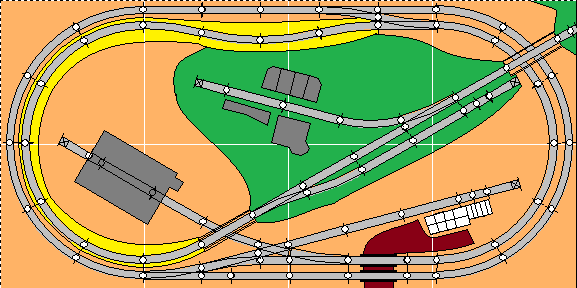 |
Plan Name: 2x40001. The best trackplan I ever came up with. You get continuous action, the visual appeal of two levels, a branch line with interchange, and three decent-sized industries, all in 2x4' - such a deal! The crossing in front gives the look of a major junction. I'm in the process of building this one; trains are running and some basic scenery is in place. |
| Plan Name: 2x40002. An unabashed double-track spaghetti bowl, but at least this one leaves room for the buildings. This could make an interesting city scene, especially with a two-sided scenic backdrop separating the yard from the industries. |
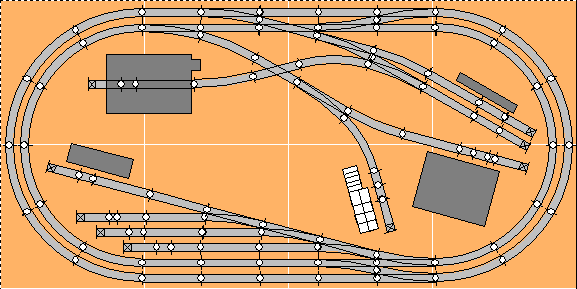 |
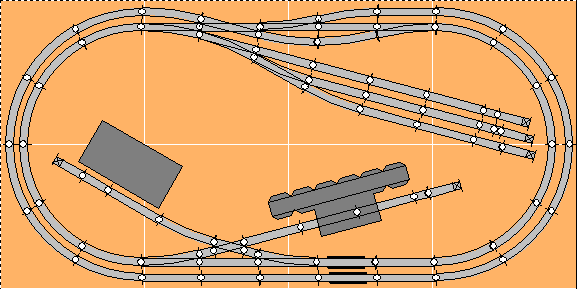 |
Plan Name: 2x40003. The turnouts at the top change a simple oval into a twice-around for a long mainline run. A small yard and two big industries will keep a train busy. |
| Plan Name: 2x40004. This is the smallest out-and-back plan you're likely to find. It works by using the yard throat as part of the main line. The red track must be wired as a reversing section. |
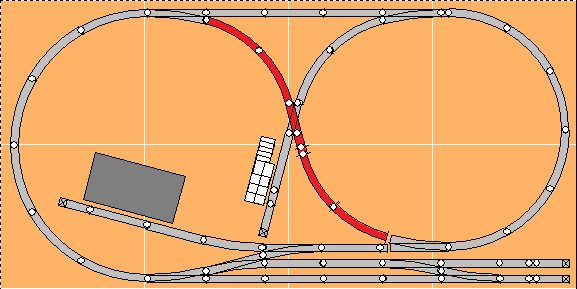 |
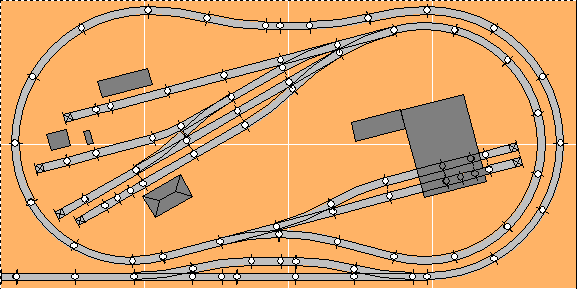 |
Plan Name: 2x40005. A point-to-point layout representing a short line. Trains will leave the central yard, drop off and pick up cars at the interchange at the bottom, and switch the industries en route. This could easily be made as a two-level pike. |
| Plan Name: 2x40006. This layout offers a little of everything -- two main lines for continuous running, a small yard, and some industries. |
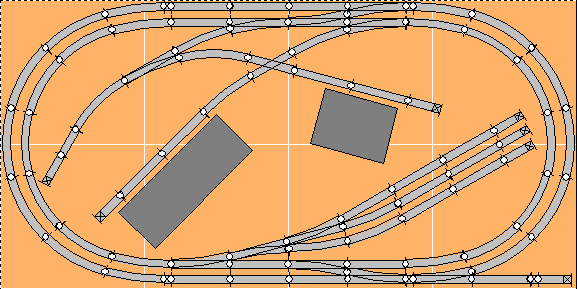 |
 |
Plan Name: 2x40007. This up-and-over dogbone plan yields the longest mainline run you'll find in a table this size, if you can live with a really tight fit around the edges of the table. I've built it using a 49x25" table, and it was close. |
| Plan Name: 2x40008. You can run a rural shortline with this plan. It looks like there's no runaround track, but the center cutoff track can be used to run around cars so you can switch all the spurs. The spur on the left is the interchange track, which is vital to any shortline. |
 |
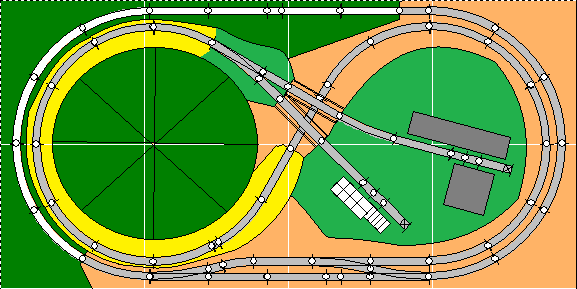 |
Plan Name: 2x40009. Care to model a shortline and its interchange with a mainline? On this layout, the mainline train comes out of its hidden track, swaps empties for loads at the interchange, and returns to staging. The shortline engine picks up the empties, takes them to the coal mine, and returns the empties to the interchange. The spartan engine facilities are also at the top of the mountain. Trains will have to be short - you can't have everything! |
Plan Name: 2x40010. This busy layout represents a maintenance area that can handle any freight car:- Interchange track
- Car clean-out track
- Car cleaning facility
- Cars awaiting cleaning or repair
- Car maintenance shop
- Rip track for light repairs
- "Dead" car storage
- Engine pocket
- Yard office
|
 |
 |
Plan Name: 2x40011. A two-level point-to-point layout, great for a coal-mining or logging theme. Trains run down from the central yard to the interchange at the bottom, and back up again. |
| Plan Name: 2x40012. For the railroader who can't get enough grade crossings, I offer this plan. There are six of them here, and only two are the same angle! The double main line allows two trains to run at once, and with all the industries, this layout would be a challenge to switch. |
 |
 |
Plan Name: 2x40013. On this layout, the inner branch line is actually longer than the main line. I'd elevate that branch about 1/2" for visual effect. Two good-sized industries and an interchange track will keep a train busy. |
| Plan Name: 2x40014. This busy city railroad could keep a switcher busy for hours. Here, the diverging routes from the interchange form a reversing loop, so with a little planning, you can switch the many spurs without any runaround moves. |
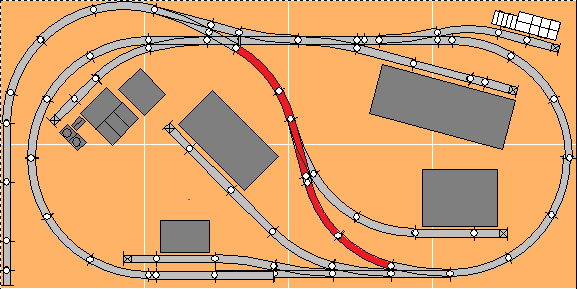 |
 |
Plan Name: 2x40015. This switching module is a condensation of Fox Lake, WI, a prototypical reverse loop. Industries include a lumber yard, a warehouse, an oil dealer, a large cannery, and a feed mill. (See the Feb 1976 Model Railroader for more info.) The loop's tail could connect to a bigger layout, a fiddle yard, or staging tracks. |
| Plan Name: 2x40016. If you want a big industry in a small space, here's an idea-starter. I used the Walthers paper-mill complex, plus a couple of smaller industries. The plan also includes an interchange track on the right, a hidden staging track at the top, and room for some scenery. |
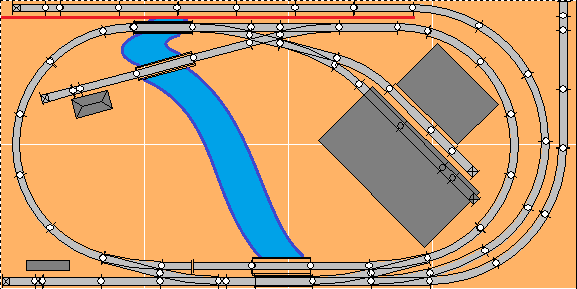 |
 |
Plan Name: 2x40017. On this plan, a scenic divider separates the yard and engine facility from the railroad's one big industry. The emphasis would be on switching the cars in the yard so they'll be in the right order when the road engine switches the industry. |
| Plan Name: 2x40018.Atlas likes the concept of an oval with a figure-eight inside; this is my take on that idea in 2x4'. Most of the curve radii are 9-3/4", and the runaround track at the bottom is barely long enough for one 40' car, so your equipment will have to be short. In exchange for that sacrifice, you get two mainline routes, the busy effect of twin crossings, and a spur that is almost long enough to be a branch line. |
 |
 |
Plan Name: 2x40019.This busy little plan features a small yard, three industries, an interchange track (the crossing track at the top), and multiple switchbacks. This is the kind of plan that a switching fiend might love. |
| Plan Name: 2x40020. A scenic divider breaks this double-track layout into two scenes. One is a surprizingly big yard with an engine house; the other serves some big industry made of DPM modules. The lone runaround track will make you plan your switching moves well in advance. |
 |
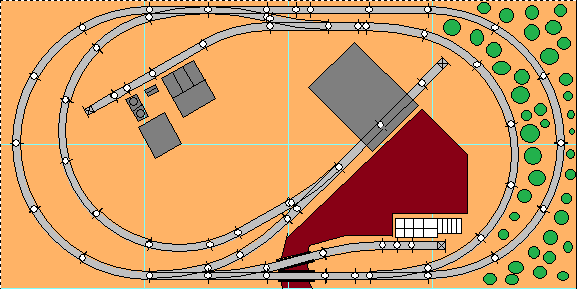 |
Plan Name: 2x40021. I doubt you'll ever see a true loads-in, empties-out plan in 2x4, but this one comes close. Loads go into the big industry (a coal-washing plant?) via the long curving spur, and out by the short spur; empties move the opposite direction. Two other industries add variety. |
| Plan Name: 2x40022. Here's a special-purpose trackplan for the modeler who loves his/her engines. An Atlas turntable and roundhouse, and a Walthers backshop, are the main attractions here. There's an ash dump track at upper right, a diesel fuel rack at lower left, and coal, sand, and water for steamers at center bottom. |
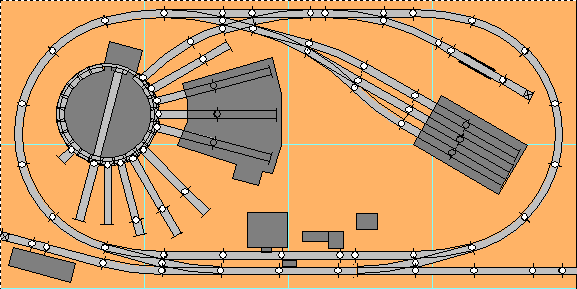 |
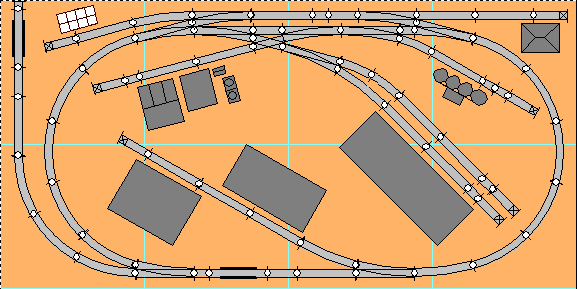 |
Plan Name: 2x40023. If you like your industries, this layout may be what you need. The long interchange track at left feeds seven assorted industries, with room for at least 12 cars. If it weren't for the closed oval, this could be considered a switching layout. |
| Plan Name: 2x40024. This simple plan is for the mountain-scenery lover who doesn't have much room. The bottom portion of the layout features a tall trestle crossing a valley. If you don't already know how you'd handle such a scene, this plan isn't for you. The top is nothing but three staging tracks, and probably wouldn't need any scenery at all. |
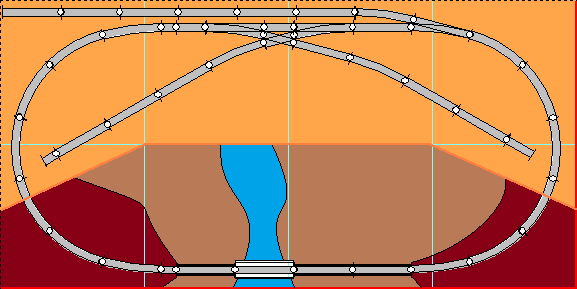 |
 |
Plan Name: 2x40025. Someone e-mailed me and asked for a 2x4' plan with a car float, so I drew up this one. The emphasis is on interchanging cars between the float (which could be removable) and the two diverging lines that head north and south. There are also two industries, a small engine shed and service area, and room for some harbor scenery. |
| Plan Name: 2x40026. This is a folded dogbone on one level. It gives a long mainline run. You can have some fun switching cars between the industry and the interchange track, and there's room for some impressive scenery. |
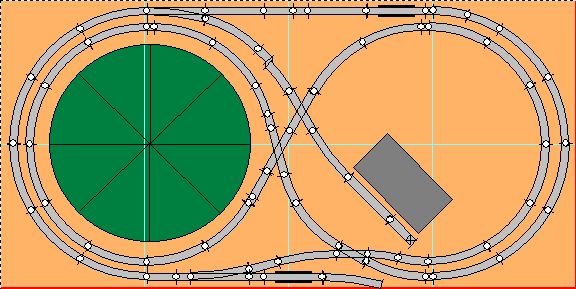 |
 |
Plan Name: 2x40027. Engines are expensive; track is cheap. If you have a switcher and a road engine and would like to gove them a work-out, check this plan out. The four-track yard gives you room to make and break trains on the arrival track outside the oval, while the interchange and three spurs give a freight train something to do. The engine house and engine pocket complete the scene. |
| Plan Name: 2x40028. Another two-level point-to-point design. This one has short runaround tracks at both stations and the interchange, so handling freight cars in any direction is doable. You could even use the runarounds as escape tracks for a switcher if a doodlebug or RDC made a run up the hill. |
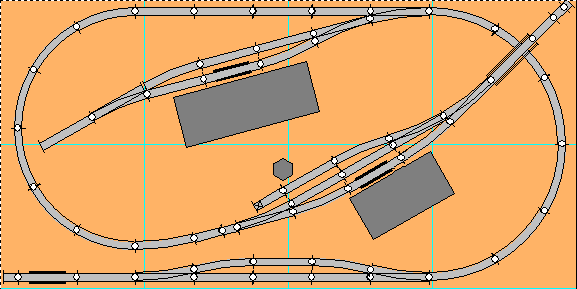 |
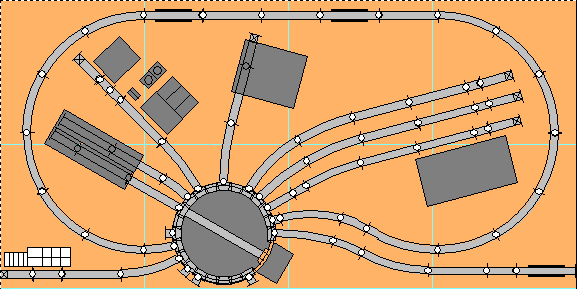 |
Plan Name: 2x40029. Just for fun, a layout with no turnouts! And yet you get continuous operation, a small yard, four industries, and interchange. Everything runs through the Atlas turntable, which can hold a GP-7 and a 40' car, or a SW-1200 and a 50' car. |
| Plan Name: 2x40030. This is essentially a switching layout with provision for continuous running. The three industrial spurs are so interlaced with the reversing connection (which is also the only runaround) that it isn't always obvious which way the engine should go to make its deliveries. |
 |
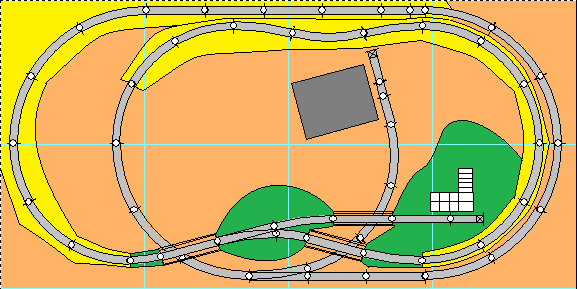 |
Plan Name: 2x40031. Vertical twice-arounds eat up a lot of space; this is about the best I can do in 2x4'. A small industry on each level gives a freight train something to do, but this plan's focus is the scenery and the bridges.
|
| Plan Name: 2x40032. This is another urban layout. A switcher can be full-time busy shuttling cars from the yard to the industries and back, while another train runs freely on the outside main line. |
 |
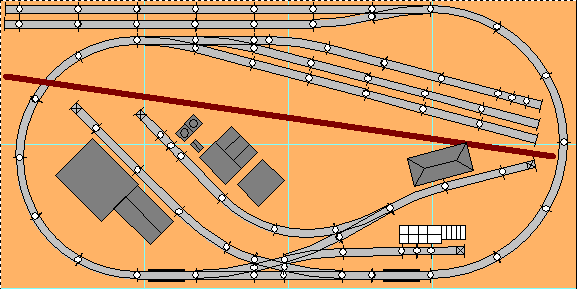 |
Plan Name: 2x40033. This is a British-style layout, where trains enter the scene from staging, do some work, and then leave. This one has double-ended staging so trains can come and go from both directions. You can have four trains, or five if at least one train returns in the direction it came instead of continuing onward.
|
| Plan Name: 2x40034. This is another British-style layout, with provision for five trains. One of them will have to be very short; an RDC or doodlebug will fit nicely on that one really short staging track. |
 |
 |
Plan Name: 2x40035. If you like trolleys and streetcars, this plan may suit you. In only 2x4 feet, you get two branching routes with five stations to visit, plus the car barn. Grades are 4%, which is no problem for a single streetcar. You could play this layout like a game for two operators, each with one streetcar: take turns drawing cards that represent each of the five stations, double the cards for Oak Street Station because it's the biggest, and the car barn. Then find the most efficient way for both of you to move to your new destinations. |
| Plan Name: 2x40036. Here's a logging layout if you want to find work for a Shay or similar geared locomotive, or better yet, two of them. There are two logging camps at the top of the hill, and the only runaround track is at the bottom, and it's only long enough for one freight car at a time. The trains to Camp #2 are straightforward switchback runs, but running to Camp 1 will require you to rearrange your train at the start and the end of your run. |
 |
 |
Plan Name: 2x40039. Here's a very simple plan that still allows realistic switching. It features one big industry, the bakery that gives us those delicious Dig Dogs, Ha Has, and Yellow Chemical Cakes. It has spots for two boxcars, one covered hopper under the structural bridge, and one tank car. Cars enter and exit the layout via the interchange at upper left. The track beyond the crossing at upper right should look weedgrown and abandoned, and the interlocking tower there should be boarded up. The bakery should look like it started small and received many additions as the years went by. |
| Plan Name: 2x40041. This is a simple switching layout with one medium-sized industry and two smaller industries. What sets this one apart from most other switching layouts is that it's a double-decker. The interchange is the elevated track at the top right corner. Your switcher picks up cars there, descends the 3.25% grade to ground level, and switches the industries there. There's room for some scenery here, beyond the usual urban area. |
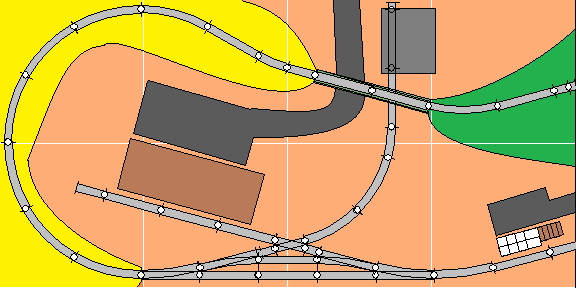 |